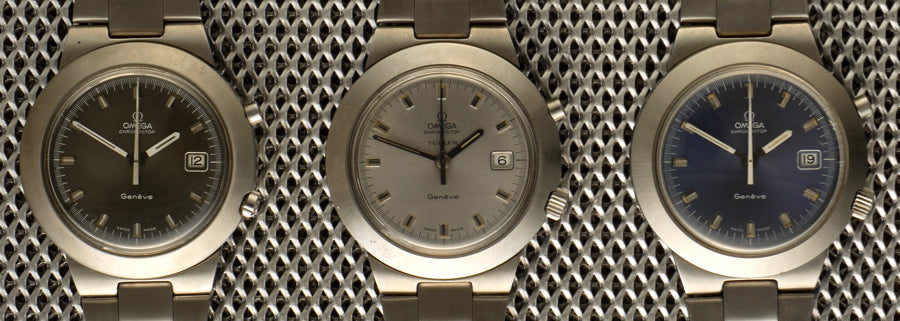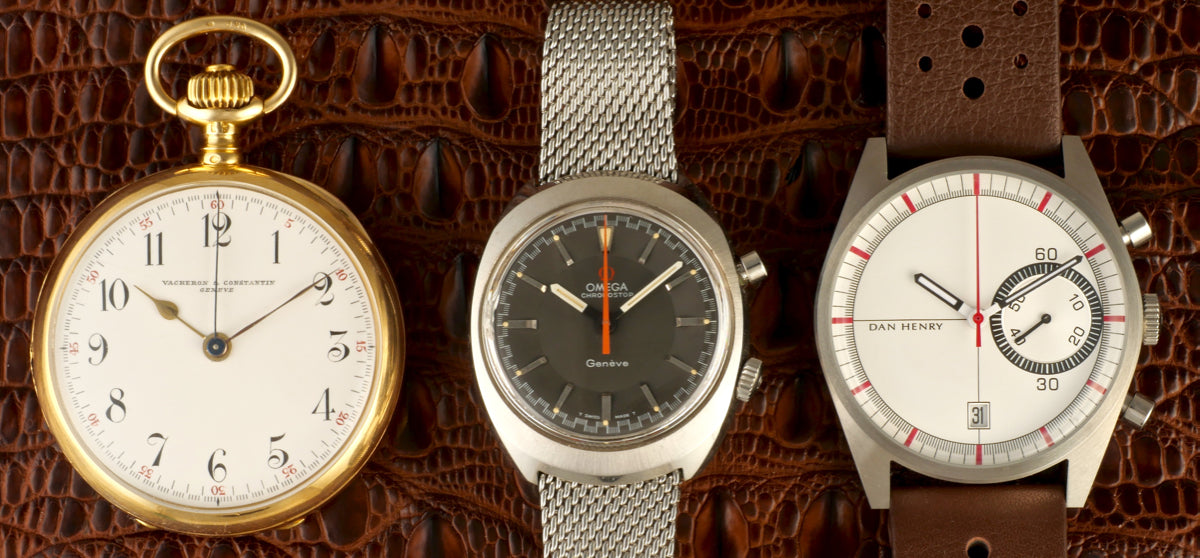The Omega Chronostop
It’s easy to find articles about the "classic” vintage watches, such as the Speedmaster, Submariner, Zenith El Primero, or Heuer Autavia. I thought it would be interesting to explore one of Omega's least remembered and most misunderstood watches: the Chronostop.
 Unlike conventional chronographs that record seconds, minutes, and hours with two or three subdials, the Chronostop was designed to be used for short interval timing -- less than one minute -- with a central hand for seconds and a single pusher.
Unlike conventional chronographs that record seconds, minutes, and hours with two or three subdials, the Chronostop was designed to be used for short interval timing -- less than one minute -- with a central hand for seconds and a single pusher.
Omega released the Chronostop in 1966. Originally intended to be part of the Seamaster collection, the Chronostop was transferred to the Geneve collection in 1967 as a lower-priced chronograph watch for younger buyers.
Echoes of the Speedmaster
Despite the low price, the Chronostop was a premium model. The watch’s movement seemed simple, but it was a high-accuracy, high-beat, high-quality engine, essentially a simpler version of the movement that powered the Speedmaster. Omega used two movements for its Chronostop models: the cal.920 (with a date), and the cal.865 (no date). Both manual-wind movements had 17 jewels, run at a rapid 21,600 Bph, and were used only on the Chronostop.
The cal.865 movement was introduced in 1966 and Omega used that model for 124,000 Chronostops. The cal.920 movement appeared in 1968 and was used for 61,000 watches.

The Chronostop was well-regarded within the watch industry: the watch won the 1967 Honor Prize for “Chronographs and Sport Watches” in the competition sponsored by the Swiss Watchmaking Federation to boost creativity.
The Chronostop also took the first prize for Industrial Aesthetics at the Utrecht Spring Fair in 1968.
An Official Olympic Timer
Even though the Chronostop featured only one measurement function, it was selected as the official Omega timer at the Pan-American Games in Winnipeg and the 1968 Olympic Games in Mexico. Available in olive green, red, white, and blue, the Mexico Olympics versions of the watch used the cal.920 movement with the date function and included dial-matching leather straps.
Chronostop Variations
Omega made the Chronostop in four different shapes and sizes. I prefer the design of the large, cushion-case Chronostop, especially the models with rotating inner bezels. These bezels feature fixed tachymeters, pulsemeters, telemeters, decimal scales, or even 60-minute diving timers. The Regatta has a 60-0 scale with the last ten minutes marked in blue and red. The Pilot’s scale has numerals graduated in pairs from 12-24, 1-13 and 2-14 onwards to show the time in 24 and 12 hour time zones. With such colorful trim, this watch has acquired the nickname, “the Roulette.”

In 1970, Omega relisted a Chronostop model made specifically for the Italian marked; this variation had a roundish “UFO” Omega Dynamic case and used the same integrated strap system.

Buying a Chronostop
If you’re looking for a Chronostop, there are three things to consider: First, look for an original Plexiglas crystal with a flat top, beveled edges, and (almost always) a tiny Omega sign at its center. The crystals used for repair are frequently domed, and don’t look correct for this model.
Second, check the dial carefully; the tritium lume plots at each five-minute marker have a habit of pulling away from the dial surface. If your watch technician has serviced and cleaned the watch, that’s fine – otherwise, the lume can find its way into the movement.
Finally, check the case – the upper sloping top of its surface should be brushed, which was a standard feature. Many Chronostops have been polished to remove scratches and lost their brushed finish.
 I am not a big fan of the small models, which I have bought only because they were in excellent condition or available for a price I couldn’t resist. To me, the most interesting of these smaller watches for me is the Driver. Omega advertised the model as a driver’s watch that could be worn on the inside of the wrist so it would be visible when your hands are on the steering wheel.
I am not a big fan of the small models, which I have bought only because they were in excellent condition or available for a price I couldn’t resist. To me, the most interesting of these smaller watches for me is the Driver. Omega advertised the model as a driver’s watch that could be worn on the inside of the wrist so it would be visible when your hands are on the steering wheel.
The Omega Seamaster Rally – or ‘Bullhead’ because of the placement of its pusher and crown -- was available only in 1969, and is hard to find. Inside the case is the 27CHRO cal.930 movement that powers the date and 30-minute counter. The Rally is - in my view - not really a Chronostop because it differs so much from the other watches in the collection. In fact, I think it was a mistake for Omega to the Bullhead to the Chronostop line.
Using the Stopwatch
To be honest, the Chronostop is not the most functional chronograph ever made, but at least it is fun to use. The orange second hand for the stopwatch is started by pressing the single pusher, then pressed again and held to freeze the hand and read the seconds. Release the pusher and the hand fly back to 12 o’clock zero.
Despite the limitations of the Chronostop, some people found a good use for the specialized stopwatch: doctors and nurses used the timer to take patients’ pulses, and engineers and technicians working with production lines found the feature to be handy.
There are many other chronographs with a duration of fewer than 60 seconds; as you can see in this Vacheron (below left) from the end of the 19th century. I used the same concept in our model 1968 (below right).

The Chronostop will be remembered for its unique place in the Omega line; it continues to appeal to collectors interested in its specialized functions.







